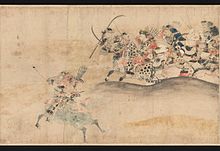| Gosannen War | |||||||
|---|---|---|---|---|---|---|---|
| Part of Clan disputes of the Heian period | |||||||
 | |||||||
| |||||||
| Belligerents | |||||||
| Forces of various branches of Kiyohara clan |
Forces of Minamoto no Yoshiie Governor of Mutsu province | ||||||
| Commanders and leaders | |||||||
|
Kiyohara no Iehira Kiyohara no Takahira Others |
Minamoto no Yoshiie Fujiwara no Kiyohira | ||||||
The Gosannen War (後三年合戦, gosannen kassen), also known as the Later Three-Year War, was fought in the late 1080s in Japan's Mutsu Province on the island of Honshū.[1]
History[edit]
The Gosannen War was part of a long struggle for power within the warrior clans of the time.
The Gosannen kassen arose because of a series of quarrels within the Kiyohara clan (sometimes referred to as "Kiyowara"). The long-standing disturbances were intractable. When Minamoto no Yoshiie, who became Governor of Mutsu province in 1083, tried to calm the fighting which continued between Kiyohara no Masahira, Iehira, and Narihira.[2]
Negotiations were not successful; and so Yoshiie used his own forces to stop the fighting. He was helped by Fujiwara no Kiyohira. In the end, Iehira and Narihira were killed.[2]
During the siege of Kanezawa, 1086–1089, Yoshiie avoided an ambush by noticing a flock of birds take flight from a forest.[3][4]
In art[edit]

Much of the war is depicted in an e-maki narrative handscroll, the Gosannen Kassen E-maki, which was created in 1171.[5] The artwork is owned today by the Watanabe Museum in Tottori city, Japan.
See also[edit]
References[edit]
- ^ Varley, H. Paul. (1994). Warriors of Japan as Portrayed in the War Tales, pp. 40-45.
- ^ a b Sansom, George (1958). A history of Japan to 1334. Stanford University Press. pp. 249–252. ISBN 0804705232.
- ^ Turnbull, Stephen (1998). The Samurai Sourcebook. Cassell & Co. p. 199. ISBN 1854095234.
- ^ Turnbull, Stephen (1977). The Samurai, A Military History. MacMillan Publishing Co., Inc. pp. 22–25. ISBN 0026205408.
- ^ Varley, p. 41.
Further reading[edit]
- Turnbull, Stephen. (1998). 'The Samurai Sourcebook'. London: Cassell & Co.
Well, that’s interesting to know that Psilotum nudum are known as whisk ferns. Psilotum nudum is the commoner species of the two. While the P. flaccidum is a rare species and is found in the tropical islands. Both the species are usually epiphytic in habit and grow upon tree ferns. These species may also be terrestrial and grow in humus or in the crevices of the rocks.
View the detailed Guide of Psilotum nudum: Detailed Study Of Psilotum Nudum (Whisk Fern), Classification, Anatomy, Reproduction